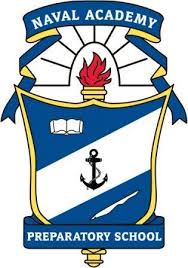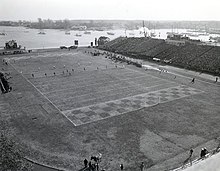
The United States Naval Academy is a federal service academy adjacent to Annapolis, Maryland. Established on 10 October 1845, under Secretary of the Navy George Bancroft, it is the second oldest of the five U.S. service academies, and educates officers for commissioning primarily into the United States Navy and United States Marine Corps. The 338-acre (137 ha) campus is located on the former grounds of Fort Severn at the confluence of the Severn River and Chesapeake Bay in Anne Arundel County, 33 miles (53 km) east of Washington, D.C., and 26 miles (42 km) southeast of Baltimore. The entire campus is a National Historic Landmark and home to many historic sites, buildings, and monuments. It replaced Philadelphia Naval Asylum, in Philadelphia, that served as the first United States Naval Academy from 1838 to 1845, when the Naval Academy formed in Annapolis.

Bancroft Hall, at the United States Naval Academy in Annapolis, Maryland, is said to be the largest contiguous set of academic dormitories in the U.S. Bancroft Hall, named after former U.S. Secretary of the Navy, and famous historian/author George Bancroft, is home for the entire brigade of 4,000 midshipmen, and contains some 1,700 rooms, 4.8 miles (7.7 km) of corridors, and 33 acres (13 ha) of floor space. All the basic facilities that midshipmen need for daily living are found in the hall. It is referred to as "Mother B" or "The Hall" by Midshipmen.

The Naval Academy Preparatory School or NAPS is the preparatory school for the United States Naval Academy. NAPS is located on Naval Station Newport, Rhode Island. The mission of the Naval Academy Preparatory School is "To enhance Midshipman Candidates' moral, mental, and physical foundations to prepare them for success at the United States Naval Academy".

Navy–Marine Corps Memorial Stadium is an open-air stadium located off the campus of the United States Naval Academy in Annapolis, Maryland. Opened in 1959, it serves as the home stadium of the Navy Midshipmen college football and lacrosse teams, and the professional Chesapeake Bayhawks of Major League Lacrosse. The stadium is also the host of the Military Bowl.
Bill the Goat is the mascot of the United States Naval Academy. The mascot is a live goat and is also represented by a costumed midshipman. There is also a bronze statue of the goat in the north end zone of Navy–Marine Corps Memorial Stadium. This statue also plays a role in "Army Week" traditions.

The Navy Midshipmen football team represents the United States Naval Academy in NCAA Division I FBS college football. The Naval Academy completed its final season as an FBS independent school in 2014, and became a single-sport member of the American Athletic Conference beginning in the 2015 season. The team has been coached by Ken Niumatalolo since December 2007. Navy has 19 players and three coaches in the College Football Hall of Fame and won the college football national championship in 1926 according to the Boand and Houlgate poll systems. The 1910 team also was undefeated and unscored upon. The mascot is Bill the Goat.

The Navy Midshipmen are the athletic teams that represent the United States Naval Academy. The academy sponsors 33 varsity sports teams and 12 club sport teams. Both men's and women's teams are called Navy Midshipmen or "Mids". They participate in the NCAA's Division I, as a non-football member of the Patriot League, a football-only member of the American Athletic Conference in the Football Bowl Subdivision (FBS), and a member of the Collegiate Sprint Football League (men), Eastern Association of Rowing Colleges (men), Eastern Association of Women's Rowing Colleges, Eastern Intercollegiate Gymnastics League (men), Mid-Atlantic Squash Conference (men) and Eastern Intercollegiate Wrestling Association. Navy is also one of approximately 300 members of the Eastern College Athletic Conference (ECAC).

Halsey Field House is a multi-purpose arena at the United States Naval Academy, in Annapolis, Maryland, with a seating capacity of 5,000. It was home to the Navy Midshipmen men's basketball team until the Alumni Hall opened in 1991. It is named after FADM William "Bull" Halsey, a World War II United States Navy commander.

The Navy Midshipmen baseball team is a varsity intercollegiate athletic team of the United States Naval Academy in Annapolis, Maryland, United States. The team is a member of the Patriot League, which is part of the National Collegiate Athletic Association's Division I. Navy's first baseball team was fielded in 1893. The team plays its home games at Terwilliger Brothers Field at Max Bishop Stadium in Annapolis, Maryland. The Midshipmen are coached by Paul Kostacopoulos.
The 1882 Navy Midshipmen football team represented the United States Naval Academy in the 1882 college football season. The team was the second intercollegiate football squad to represent the United States Naval Academy, and the first since 1879. The team was coached by player-coach Vaulx Carter, and was entirely student-operated. It was captained by squad member Alex Jackson. The team played just a single game, an 8 to 0 (8–0) shutout of Johns Hopkins, which was the school's first ever win. The squad was entirely student operated, and was not supported by the Naval Academy's faculty. The season would mark the beginning of eight season rivalry between the Midshipmen and Johns Hopkins.
The 1883 Navy Midshipmen football team represented the United States Naval Academy in the 1883 college football season. The team was the third intercollegiate football squad to represent the United States Naval Academy, and the first time the school participated in consecutive seasons. The squad was captained by member Frank Hill. The team played just a single game, a 2 to 0 (2–0) shutout loss to Johns Hopkins, which was the school's first ever loss. The squad was the first to have the approval of the academy's staff, and is regarded as the first official game played by the Midshipmen. The season continued a seven-season, eight game rivalry between the Naval Academy and Johns Hopkins.

Worden Field is a large grass field located on the campus of the United States Naval Academy in Annapolis, Maryland. First mentioned in 1890, the field served as the home stadium for the academy's Midshipmen football team from that year through 1923, replaced by Thompson Stadium in 1924. Since the early 1900s, the field has hosted all of the academy's various yearly parades and many of its drills. It has progressively grown smaller, due to the addition of buildings and roads within the academy.

The Johns Hopkins–Navy football rivalry was an American intercollegiate football rivalry between the Johns Hopkins Blue Jays football team of Johns Hopkins University and the Navy Midshipmen football team of the United States Naval Academy. The two institutions, located within the span of a few miles in the state of Maryland, first met for a football game in 1882. Following the initial contest, both teams played each other annually for eight years, before it was called off for unknown reasons. The teams competed again in 1911 and 1912, again disbanding the contest until a final match took place in 1919.
The 1884 Navy Midshipmen football team represented the United States Naval Academy in the 1884 college football season. The team was the fourth intercollegiate football squad to represent the United States Naval Academy, and was the final time the school played a single-game season. The squad was captained by rusher Jim Kittrell. The team's single game was a 9 to 6 (9–6) defeat of rival-school Johns Hopkins. The season continued a seven-season, eight game rivalry between the Naval Academy and Johns Hopkins. It was the final season that a Naval Academy team would go unbeaten and untied.
The 1885 Navy Midshipmen football team represented the United States Naval Academy in the 1885 college football season. The team was the fourth intercollegiate football squad to represent the United States Naval Academy, and marked the first time that the school played a multiple-game season. The squad was captained by halfback Cornelius Billings. The year began with a blowout victory over St. John's College, but was followed by close losses to Johns Hopkins University and the Princeton Tigers reserves squad. The season continued a seven-season, eight game rivalry between the Naval Academy and Johns Hopkins, and began a ten-game, seven-year rivalry with St. John's.
The 1977 Navy Midshipmen football team represented the United States Naval Academy (USNA) as an independent during the 1977 NCAA Division I football season. The team was led by fifth-year head coach George Welsh.
The 1954 Navy Midshipmen football team represented the United States Naval Academy (USNA) as an independent during the 1954 college football season. The team was led by fifth-year head coach Eddie Erdelatz, and they acquired the nickname "Team Named Desire" during the press conference following the 25–0 road shutout of Stanford, when Erdelatz said, "Every man on this team is full of desire."

The 2019 Navy Midshipmen football team represented the United States Naval Academy in the 2019 NCAA Division I FBS football season. The Midshipmen were led by 12th-year head coach Ken Niumatalolo and played their home games at Navy–Marine Corps Memorial Stadium. Navy competed as a member of the American Athletic Conference (AAC) in the West Division.

The 2020 Navy Midshipmen football team represented the United States Naval Academy in the 2020 NCAA Division I FBS football season. The Midshipmen were led by thirteenth-year head coach Ken Niumatalolo and played their home games at Navy–Marine Corps Memorial Stadium. Navy competed as a member of the American Athletic Conference (AAC).











